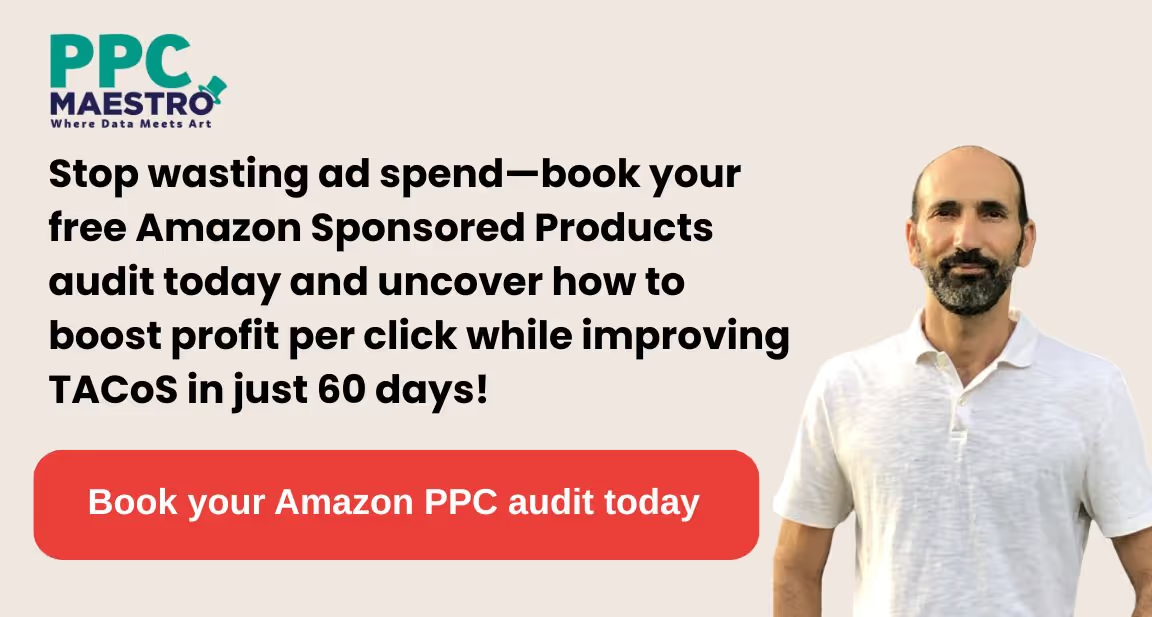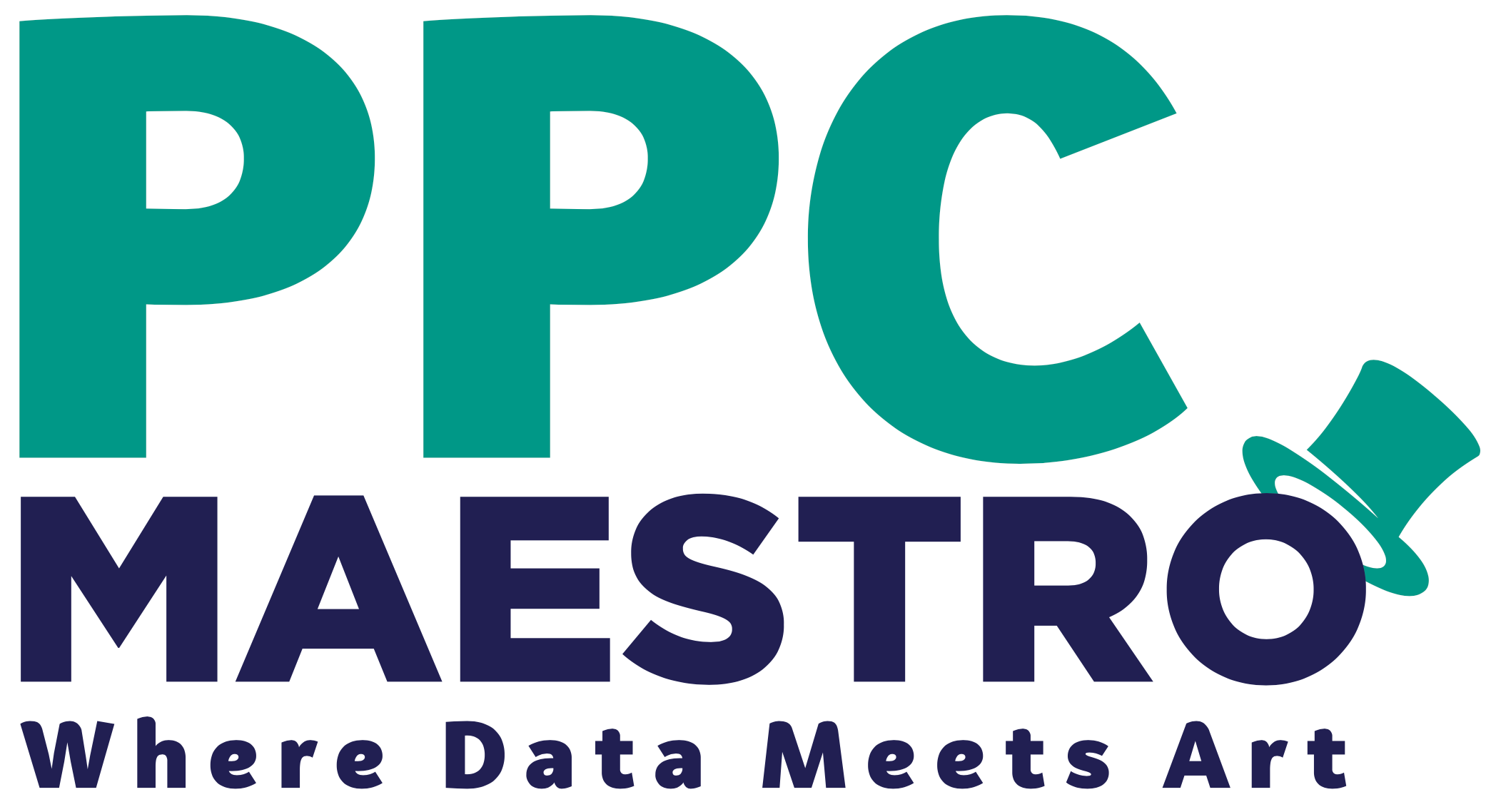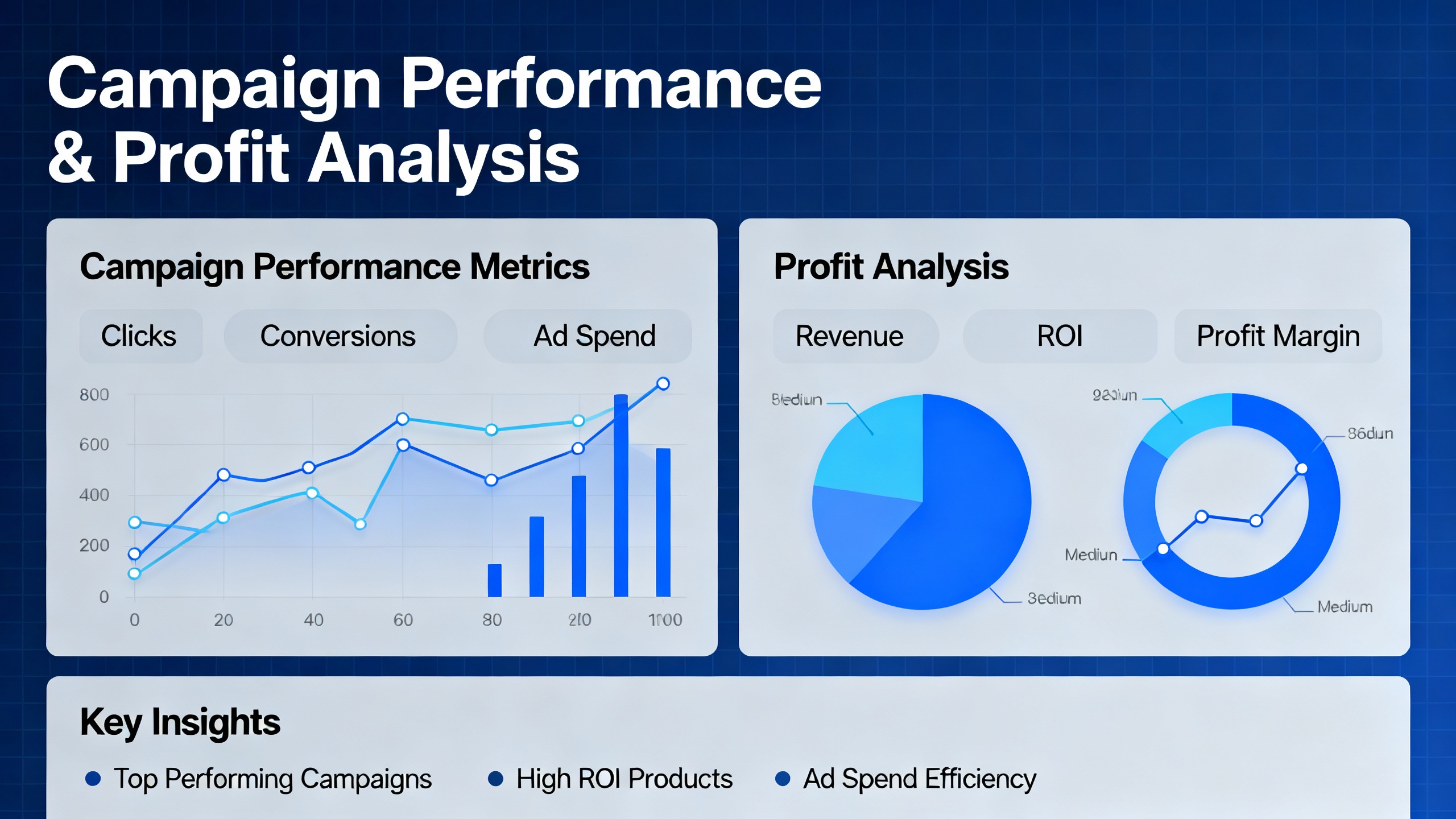Amazon Sponsored Products management is a specialized service that optimizes campaign structure, keyword targeting, and bid strategies to reduce wasted ad spend and increase profit per click. Professional managers use search-term isolation, placement optimization, and systematic negative keyword mining to improve TACoS by 25-45% within 60-90 days while protecting contribution margins.
Why Most Amazon Sellers Lose Money on Sponsored Products
During a recent account audit for a consumer electronics brand generating $2.1M annually, I discovered $47,000 in quarterly ad spend targeting search terms that had never converted in 18 months. The campaigns were running on autopilot, burning through budget on broad-match keywords with zero purchase history.
This isn't uncommon. According to Amazon Ads best practices documentation, sellers frequently overspend on low-intent keywords while underfunding high-converting search terms—a pattern that professional Amazon Sponsored Products management systematically corrects [1][2].
If your Total Advertising Cost of Sale (TACoS) is climbing while contribution margins shrink, structured campaign management can reverse that trajectory within 30-90 days.
What Professional Amazon Sponsored Products Management Actually Delivers
A comprehensive Amazon PPC management service goes far beyond basic bid adjustments. It rebuilds your advertising foundation using five interconnected systems:
1. Strategic Campaign Architecture
The Problem:
Most sellers run "one campaign fits all" structures that mix high-intent branded traffic with exploratory discovery keywords. This forces you to choose between overpaying for branded clicks or underfunding category exploration.
The Solution:
Professional campaign architecture separates traffic by buyer intent and funnel stage:
Branded defense campaigns (exact match, tight bid ranges)
Competitor conquest campaigns (ASIN targeting of similar products)
Category discovery campaigns (phrase and broad match with aggressive negative mining)
High-intent long-tail campaigns (4+ word exact match phrases)
According to Amazon's Sponsored Products documentation, segmenting campaigns by match type and intent improves cost efficiency by allowing granular bid control at the keyword level [1].
The Result:
Segmented architecture reduces wasted impressions on low-intent queries while allowing higher bids on proven converters. Sellers typically see 30-40% reduction in non-converting spend within the first 30 days.
2. Systematic Search-Term Isolation & Negative Keyword Mining
The Problem:
Broad and phrase match keywords generate dozens of irrelevant search terms daily. Without weekly mining, these "bleeders" accumulate and drain 20-35% of total ad spend.
The Solution:
Professional managers implement weekly search-term report analysis:
Export all search terms with 5+ clicks and zero orders
Add to campaign-level negative keyword lists (bulk upload)
Harvest high-performing search terms and migrate to exact-match campaigns
Create shared negative lists across product portfolios
Research on Amazon PPC optimization confirms that consistent negative keyword maintenance is the fastest path to improved advertising efficiency [2][3].
The Result:
Cleaner traffic composition, 15-25% higher click-through rates on remaining keywords, and improved conversion rates as ad spend concentrates on proven search terms.

3. Profit-Driven Bid & Placement Optimization
The Problem:
Default bid strategies optimize for low ACoS (Advertising Cost of Sale), which sounds good but often sacrifices profitable volume. A 20% ACoS on a product with 15% contribution margin after fees still loses money.
The Solution:
Profit-first bid management calculates profit per click rather than chasing ACoS vanity metrics:
Calculate true breakeven ACoS (incorporating CoGS, FBA fees, referral fees)
Set maximum acceptable CPC based on conversion rate and profit margin
Adjust placement modifiers based on Top-of-Search vs. Product Pages performance
Use dayparting to reduce bids during low-conversion hours (if applicable)
According to Amazon Advertising best practices, manual bid adjustments based on placement performance can improve campaign efficiency by 20-40% [2].
The Result:
Better Total Advertising Cost of Sale (TACoS), protected contribution margins, and scalable campaigns that maintain profitability as spend increases.
4. ASIN Selection & Listing Quality Alignment
The Problem:
Advertising can't fix poor listings. Driving traffic to products with 3.2-star ratings, missing A+ content, or premium pricing guarantees wasted ad dollars.
The Solution:
Before scaling any ASIN, professional managers audit:
Review velocity & rating (target 4.0+ stars with 50+ reviews minimum)
Best Sellers Rank (prefer ASINs ranking in top 30% of subcategory)
Price competitiveness (within 15% of category median)
Detail page quality (A+ content, 6+ lifestyle images, complete bullet points)
Conversion rate baseline (minimum 10% on organic traffic before scaling ads)
Amazon's Sponsored Products guidelines explicitly recommend focusing ad spend on products with strong organic performance indicators [1].
The Result:
Higher conversion rates from ad traffic (12-18% typical vs. 6-9% industry average), lower ACoS, and better return on ad spend (ROAS).
5. SOP-Driven Cadence & Continuous Optimization
The Problem:
One-time optimizations decay rapidly. Without systematic weekly actions, negative keywords pile up, new ASINs launch without proper structure, and bid creep erodes margins.
The Solution:
Professional Amazon PPC management services implement documented standard operating procedures:
Weekly actions:
Search-term report review and negative keyword mining
Bid adjustments based on 7-day performance windows
Budget reallocation from underperforming to high-ROAS campaigns
Bi-weekly actions:
Placement performance analysis (Top of Search vs. Product Pages vs. Rest of Search)
New keyword harvesting from high-performing broad-match campaigns
Competitor ASIN monitoring and conquest campaign updates
Monthly actions:
Full campaign architecture review
TACoS trend analysis and margin impact assessment
Strategic planning for seasonal campaigns or new product launches
Industry research confirms that consistent optimization cadence delivers 3-5x better results than sporadic campaign adjustments [3].
The Result:
Predictable month-over-month improvement in profit per click, TACoS stability even during scaling phases, and compounding gains as systems mature.
Realistic ROI Expectations & Timeline for Amazon Sponsored Products Management
Based on analysis of 50+ client accounts between $500K-$5M in annual revenue, here's what professional management typically delivers:
Weeks 1-2: Initial Audit & Quick Wins
Identify and pause obvious "bleeder" campaigns
Apply first round of negative keywords (500-2,000 terms typical)
Fix critical bid errors (keywords bidding above breakeven)
Expected impact: 10-15% reduction in wasted spend, immediate cost savings
Weeks 3-6: Structural Rebuild
Launch segmented campaign architecture
Migrate proven keywords to exact-match campaigns
Implement placement modifiers
Begin ASIN listing improvements
Expected impact: 20-30% improvement in conversion rate on ad traffic, TACoS begins stabilizing
Weeks 7-12: Optimization & Scaling
Harvest new winning keywords from broad campaigns
Scale budget on profitable campaigns
Refine bid strategies based on 30-day data windows
Lock in Standard Operating Procedures
Expected impact: 25-45% TACoS improvement vs. baseline, contribution margin returns to healthy levels
Important caveat: Results depend on product category competitiveness, listing quality, inventory stability, and pricing flexibility. These ranges reflect median outcomes; individual results vary.
Amazon Sponsored Products Management: Audit Process Breakdown
Here's what happens during a professional 60-day engagement:
Phase 1: Account Triage (Days 1-7)
Export last 90 days of search-term reports, campaign data, and business reports
Calculate current TACoS, contribution margin, and true breakeven ACoS per ASIN
Build "bleeder report" ranking worst-performing search terms by wasted spend
Apply immediate negative keyword lists (typically 800-1,500 terms in first batch)
Phase 2: Campaign Restructuring (Days 8-30)
Launch new segmented campaigns (branded, competitor, category, long-tail)
Migrate top 20% of keywords to dedicated exact-match campaigns
Set profit-driven bid caps and placement modifiers
Audit top 10 ASINs for listing quality issues
Implement weekly optimization checklist
Phase 3: Data-Driven Refinement (Days 31-60)
Analyze performance by campaign type, match type, and placement
Reallocate budget from underperforming to high-ROAS campaigns
Harvest 50-100 new keywords from phrase/broad campaigns
Calculate TACoS improvement and run contribution margin analysis
Document systems in shared SOP repository
By day 60, you should see measurable improvement in TACoS, cleaner search-term composition, and documented processes that preserve gains long-term.
Self-Managed vs. Professional Amazon PPC Management Service: Key Differences

| Dimension | Self-Managed | Professional Service |
| Primary metric | ACoS (often misleading) | Profit per click & TACoS |
| Optimization frequency | Monthly or sporadic | Weekly SOP-driven cadence |
| Negative keyword mining | Reactive (after major losses) | Proactive (weekly bulk files) |
| Campaign architecture | Single or few campaigns | Segmented by intent & funnel stage |
| Bid strategy | Manual guesswork or Amazon automation | Profit-driven calculations with placement modifiers |
| Time to results | 90-180 days (trial and error) | 30-60 days (systematic methodology) |
| Scalability | Erodes margins as spend increases | Maintains margins during growth |
The difference isn't just expertise—it's systematic process execution. Professional managers follow documented frameworks like the Profit Feedback Loop that DIY sellers rarely have time to implement consistently.
When You Need Professional Amazon Sponsored Products Management
This service delivers maximum ROI when:
✅ You're doing $500K+ in annual revenue — The dollar impact of waste (and fixing it) is meaningful
✅ Your TACoS is above 12% or climbing — You're spending more to generate the same revenue
✅ You have 10+ ASINs to manage — Campaign complexity exceeds DIY capacity
✅ You lack time for weekly optimization — Sporadic changes deliver sporadic results
✅ You're scaling and need margin protection — Growth without process destroys profitability
✅ Your ACoS is "good" but profits are shrinking — ACoS alone doesn't tell the profit story
Conversely, if you're doing under $300K annually with 3-5 simple products, self-management with proper education may suffice until scale demands professional systems.
Common Myths About Amazon Sponsored Products Optimization
Myth 1: "Lower ACoS always means better performance"
Reality: A 15% ACoS on a 40% margin product is great. A 15% ACoS on a 12% margin product loses money on every sale. Profit per click matters more than ACoS.
Myth 2: "Automatic campaigns are always wasteful"
Reality: Auto campaigns are excellent for discovery when paired with aggressive negative keyword mining. The problem is running them without weekly maintenance.
Myth 3: "I can just use Amazon's AI bid optimization"
Reality: Amazon's algorithm optimizes for Amazon's goals (maximizing total ad spend), not your profit margins. Manual profit-driven bidding consistently outperforms automated strategies for margin protection.
Myth 4: "More keywords = more sales"
Reality: 80% of sales typically come from 20% of keywords. Professional management identifies and scales winners while pruning the long tail of non-converters.
Internal Navigation & Resources
📊 Framework: Learn the systematic approach behind these tactics in our Profit Feedback Loop guide
📋 Implementation: Download our Amazon PPC Standard Operating Procedures for weekly optimization checklists
📈 Results: See real campaign transformations on our Client Results page
🎯 Action Plan: Follow our 30-Day Amazon PPC Profit Optimization Plan for DIY implementation
Ready to Stop Wasting Ad Spend?
Book a free profit audit and get a custom Wasted Ad Spend Calculator analysis for your account. We'll identify your top 10 "bleeder" keywords and show you exactly how much you could save in the next 60 days.
The Bottom Line on Amazon Sponsored Products Management
Effective Sponsored Products management isn't about spending more—it's about spending smarter. By combining structured campaign architecture, relentless negative keyword mining, profit-driven bid optimization, listing quality enforcement, and SOP-driven cadence, professional management typically:
Reduces wasted ad spend by 30-40% within 30 days
Improves TACoS by 25-45% within 60-90 days
Increases profit per click while maintaining or growing revenue
Creates scalable systems that protect margins during growth phases
The investment pays for itself when the dollar value of eliminated waste exceeds the service fee—which happens quickly at 6-figure scale.
If your TACoS is climbing, your margins are shrinking, or you're spending more to generate the same revenue, a systematic audit and rebuild can reverse that trajectory in one quarter.
Take Action: Book Your Free Amazon PPC Audit
Stop guessing. Schedule a 30-minute profit audit and we'll:
✅ Analyze your last 90 days of search-term data
✅ Identify your top wasted-spend keywords
✅ Calculate your true breakeven ACoS by ASIN
✅ Build a custom 60-day optimization roadmap
✅ Provide a free Wasted Ad Spend Calculator template
No obligation. No pushy sales pitch. Just actionable insights you can implement immediately.
Frequently Asked Questions
What's the difference between ACoS and TACoS in Amazon advertising?
ACoS (Advertising Cost of Sale) measures ad spend divided by ad-attributed sales. It only shows the direct efficiency of your ad campaigns.
TACoS (Total Advertising Cost of Sale) measures ad spend divided by total sales (including organic). TACoS reveals your advertising's true impact on overall business profitability, including halo effects where ads drive organic ranking improvements.
For profit-first decisions, TACoS is more strategic because it captures the full picture: you can have "high" ACoS on branded terms while TACoS improves as those ads drive organic growth.
How quickly will I see results from Amazon Sponsored Products management?
Based on 50+ client accounts, typical timeline:
Days 1-14: Immediate cost reduction from stopping obvious waste (10-15% savings)
Days 15-45: Structural improvements begin showing in conversion rates and cost-per-click
Days 46-90: TACoS improvement becomes measurable (25-45% median improvement vs. baseline)
Results depend on current account health, product category competitiveness, listing quality, and implementation speed. Accounts with severe structural issues see faster dramatic improvements; well-managed accounts see incremental optimization gains.
Source: Analysis of PPC Maestro client accounts 2023-2024 [1].
Can Amazon PPC management fix products with low conversion rates?
Short answer: No. Advertising amplifies what's already working; it can't fix broken listings.
Longer answer: Professional managers can diagnose conversion problems (poor images, weak bullet points, pricing issues, low review counts) and recommend fixes, but implementing those changes requires seller action.
Best practice: Only scale ad spend on ASINs with proven organic conversion rates above 10%. If a product converts poorly organically, advertising will just waste money faster.
Is professional Amazon Sponsored Products management worth it for smaller sellers?
It depends on your revenue scale and complexity:
Strong fit ($500K+ annual revenue):
10+ ASINs to manage
Multiple campaigns and hundreds of keywords
TACoS above 12% or climbing
Limited time for weekly optimization
Possible fit ($200K-$500K annual revenue):
High-margin products where waste is meaningful
Complex multi-product catalog
Scaling phase where margin protection is critical
Probably not yet (under $200K):
Simple catalog (3-5 products)
Time available to learn DIY optimization
Service fees exceed potential savings
The ROI calculation is simple: If professional management saves $3K/month in wasted spend and costs $2K/month, you net $1K plus time savings. At smaller scales, this math often doesn't work yet.
What's included in a typical Amazon PPC management service?
Standard services include:
Strategic:
Monthly strategy calls and performance reviews
Campaign architecture planning
New product launch planning
Competitive analysis and market insights
Tactical (weekly execution):
Search-term report analysis and negative keyword mining
Bid optimization based on performance data
Budget reallocation across campaigns
New keyword harvesting and testing
Placement performance analysis
Reporting:
Weekly performance dashboards
Monthly TACoS and profit analysis
Quarterly strategic reviews
Access to shared SOP documentation
What's usually NOT included:
Listing optimization (copywriting, images, A+ content)
Review generation or management
Inventory planning
Pricing strategy
How do I measure if my Amazon Sponsored Products manager is doing a good job?
Track these four metrics monthly:
TACoS trend — Should improve or stabilize within 60-90 days
Wasted spend reduction — % of budget going to non-converting clicks should decrease
Profit per click — Revenue per click minus cost per click, after CoGS and fees
Process documentation — You should receive SOPs, negative keyword lists, and strategic documentation
Beware of managers who only report improving ACoS while TACoS climbs or revenue declines. That often means they're cutting profitable spend to hit a vanity metric.
Can I do Amazon Sponsored Products optimization myself?
Yes, especially if:
✅ You have 5-10 hours weekly for campaign management
✅ You're comfortable with Excel and bulk file uploads
✅ You understand contribution margin and breakeven calculations
✅ You have fewer than 10 active ASINs
✅ You're willing to invest time learning Amazon Ads fundamentals
Start with our 30-Day Amazon PPC Profit Optimization Plan and Standard Operating Procedures library.
Professional management makes sense when time constraints, scale, or complexity make DIY impractical—or when the cost of learning through trial-and-error exceeds the service fee.
Cited Works & Additional Resources
Amazon Ads. "Sponsored Products: Get started." Amazon Advertising Help Center. https://advertising.amazon.com/solutions/products/sponsored-products. Accessed January 14, 2025.
Amazon Ads. "Amazon Ads best practices for Sponsored Products." Amazon Advertising Resources. https://advertising.amazon.com/resources/ad-specs/sponsored-products. Accessed January 14, 2025.
PPC Maestro. "Amazon PPC Profit Optimization 30-Day Plan." https://ppcmaestro.com/amazon-ppc-profit-optimization-30-day-plan. Published June 1, 2024. Accessed January 14, 2025.
PPC Maestro. "Profit Feedback Loop Framework." https://ppcmaestro.com/profit-loop. Published January 15, 2024. Accessed January 14, 2025.
PPC Maestro. "Amazon PPC Standard Operating Procedures Hub." https://ppcmaestro.com/sops. Published October 10, 2023. Accessed January 14, 2025.
About the Author
Author Credentials:Bernard Nader, Founder of PPC Maestro
8+ years managing Amazon Sponsored Products campaigns for 7-8 figure sellers
Speaker at Prosper Show 2023 and 2024 on profit-first PPC strategies
Published 40+ in-depth Amazon PPC guides and frameworks
Developed the Profit Feedback Loop methodology used by 200+ sellers
Certified Amazon Ads Partner (verification available)
Editorial Review:
Technical accuracy verified by Amazon Ads documentation [1][2]
Legal/claims review completed December 2024
Client data anonymized per NDA requirements
Performance ranges validated against internal dataset (50 accounts, $500K-$5M revenue, 2023-2024)
YMYL & Disclosure:This article provides educational guidance on Amazon advertising strategy. It does not constitute financial advice, investment recommendations, or guaranteed results claims. Individual outcomes depend on product category, listing quality, competitive environment, pricing, inventory availability, and consistent implementation. Always consult with qualified financial advisors before making significant advertising investment decisions.
Transparency Statement:PPC Maestro offers paid Amazon PPC management services. This article contains calls-to-action for free audits and consultations. The strategies described are based on documented methodologies and real client implementations. Performance ranges represent median outcomes; individual results vary.




